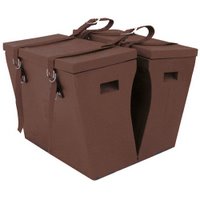So you are ready to start packing. You’ve got your pack horse or pack mule. You have chosen a Decker Pack Saddle or a Sawbuck Pack Saddle. You have chosen your pack pad. Now it is time to choose the panniers. But which ones? Below I have outlined some options and have also let you know what I like to use when I go on a horse pack trip.
Types of Pack Panniers
There are several styles of pack saddle panniers (or saddle packs, as I have sometimes heard them called) which can be quickly grouped as either hard panniers or soft panniers. Hard panniers, as the name suggested, are a box type carrier made from a solid material like wood, aluminum or molded plastic. Soft panniers are more of a bag style made from materials such as canvas, leather, vinyl, etc.
Hard Panniers
Each material used in hard panniers has its pros and cons.
Wood is solid and strong, but heavy. Wooden pack boxes are usually mantied. Also wood is porous and can take on water and may shatter more easily in a wreck than other types of hard panniers.
Aluminum panniers are lighter weight, but are also noisy and dent easily when banged against trees and rocks. Once dented, it can be difficult to reshape them back to their original form, which can prohibit your lid from fitting correctly again.
Molded plastics are lightweight, but tough and can be shaped to fit the animal’s body. They seem to survive wrecks as well, if not better, than the other types of materials. These panniers are strong enough to be used as a step stool or seat in camp and some models are designed to convert to a table or flat work surface. I personally prefer hard panniers made from molded plastic.
Molded plastic hard panniers 
There are three types of molded plastic hard panniers: horse shaped, box shaped and bear resistant. Horse-shaped pack boxes, like our Ralide-West HorsePacs, are curved in the back to follow the shape of your pack animal’s ribs. These panniers hang straighter on the animal and, therefore, provide you with a slightly narrower load and a flatter shelf for your top pack. We have recently redesigned the Ralide-West HorsePac Pannier with molded handles and to double as a table or flat work surface with the purchase of a pannier leg set. However, the curved shape of these boxes affects the amount and shape of the packing space available inside the pannier. You have to work around the curve and large, square items may not fit as well in these pack boxes. Box-shaped panniers, on the other hand, like our Ralide-West ProPacs, are rectangular in shape, which can simplify packing your gear on a horse pack trip. These panniers are large enough for a smaller wall tent stove like the Riley Side Kick. However, the rectangular shape does not lay flat against the animal, so your pack load is a little wider going down the trail and the pack boxes ride at more of an angle. This means the tops of the boxes will not be as flat, but your top pack will ride just fine.
Box-shaped panniers, on the other hand, like our Ralide-West ProPacs, are rectangular in shape, which can simplify packing your gear on a horse pack trip. These panniers are large enough for a smaller wall tent stove like the Riley Side Kick. However, the rectangular shape does not lay flat against the animal, so your pack load is a little wider going down the trail and the pack boxes ride at more of an angle. This means the tops of the boxes will not be as flat, but your top pack will ride just fine.
Bear Resistant Panniers (sometimes known as Bear “Proof” Panniers, although this is misleading) are designed with lids  that are inset and screwed down to keep bears from being able to pry the lid off. These panniers are often required by the Forest Service in areas with high bear populations to prevent bears from getting into human food and becoming habituated and a nuisance or danger to humans. If you travel through or camp in these areas without bear resistant panniers, you will need to hang your food to prevent bears from getting into it (100 feet from the tent, about 15 high between two trees). These panniers are shaped like our HorsePac panniers and therefore, ride well.
that are inset and screwed down to keep bears from being able to pry the lid off. These panniers are often required by the Forest Service in areas with high bear populations to prevent bears from getting into human food and becoming habituated and a nuisance or danger to humans. If you travel through or camp in these areas without bear resistant panniers, you will need to hang your food to prevent bears from getting into it (100 feet from the tent, about 15 high between two trees). These panniers are shaped like our HorsePac panniers and therefore, ride well.
Next time, I'll talk about your options for soft panniers.
Tuesday, August 15, 2006
Which panniers should I use? Part I
Subscribe to:
Post Comments (Atom)
1 comment:
I've used wooden and plastic and I'm of the opinion that wooden work fine if properly built. I still use a set my grandpa made in the sixties. Of course the convenious of ordering plastic and ready to go is undeniable.
Post a Comment